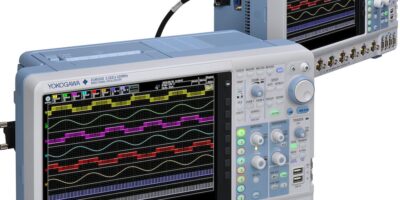DLM5000 MSO shows flexibility with eight analogue inputs
Available with options for four or eight analogue inputs, the DLM5000 is a new generation of mixed signal oscilloscope, says Yokogawa. It is the successor to eight-channel DLM4000 and features redesigned hardware to offer “major improvements” in both performance and operability, says Yokogawa. Among them is a sampling rate double that of the DLM4000.
The DLM5000 can be used for developing high-performance and intelligent power-semiconductor technologies and mechatronics applied in modern electric vehicles (EVs), motor controls and energy efficient electronic designs in a range of industries, including automotive, aerospace, railway and consumer electronics.
It offers users flexibility with up to eight analogue channels and 32 bits of logic, additional math channels, vehicle serial bus analysis, and other analysis features.
A large number of channels is key to developing efficient and reliable high-performance electric motors, explains Yokogawa. These motors, based on modern inverters, are developed using multi-channel, high speed waveform measurement. This measurement typically requires more than four channels.
To develop electronic control units (ECUs), for mechatronics systems, numerous I/O analogue, digital, and serial bus waveforms need to be measured. The DLM5000’s ability to monitor eight analogue channels and up to 32-bits of logic input (16 as standard and 16 optional), while simultaneously performing protocol analysis such as UART, I2C, SPI, CAN, CAN FD, LIN, CXPI, SENT and FlexRay, can speed up the development process.
A new feature, the DLMsync, will allow two DLM5000s to be linked and work together. This will extend measurements to gain even more information about the performance and behaviour of electronic systems. Connecting two DLM5000s with a dedicated cable enables sampling clock and trigger synchronous measurement of up to 16 analogue channels plus 64 bit logic. Alternatively, the eight channel and four channel models of the DLM5000 can be connected to give 12 channels.
The DLM5000 can be used as an eight analogue and 16 digital input mixed signal oscilloscope, with all channels able to be used simultaneously. With the /L32 option, up to 32 logic signals can be measured.
The DLM5000 also includes a Bus/State display and an optional DA calculation function, to evaluate ADCs/DACs.
Other features are low residual noise, extensive voltage ranges and a variety of real-time low pass filters to ensure signal fidelity.
A 12.1-inch touchscreen allows monitoring of waveforms, not only when inputting eight channels, but also when the number of waveforms is increased by calculation or zooming. There is also a traditional oscilloscope panel which allows users to navigate through the scope’s analysis features.
Data can be managed and accessed via the DLM5000’s large memory, which can save up to 100,000 captured waveforms. The History function allows the user to display one or all of the captured waveforms on screen and perform cursor measurement, computation and other operations on the displayed waveforms. It also allows the analysis of rarely-occurring abnormal signals, even when an appropriate trigger condition is hard to find because its waveform shapes are not constant.
The DLM5000 has dedicated serial analysis function options (/F01 to /F05) for embedded systems and in-vehicle bus signals, and decode display analysis. The logic input can also be used for specific serial buses including I2C, SPI, UART and SENT. Trigger and decode settings, such as bit rate and threshold level are automatically detected.
Simultaneous analyses of four different buses can be carried out, with waveforms and analysis results from buses with different speeds being displayed using dual zoom windows.




